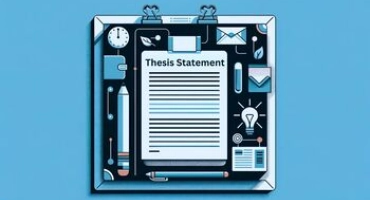How to Write a Persuasive Speech: 7 Steps
Table of contents
- 1 Guidance on Selecting an Effective and Relevant Topic
- 2 Strategies for Connecting with Different Types of Audiences
- 3 Developing Your Thesis Statement
- 4 Overview of Speech Structure (Introduction, Body, Conclusion)
- 5 Techniques for Creating a Coherent Flow of Ideas
- 6 Importance of Transitions Between Points
- 7 Importance of Tone and Style Adjustments Based on the Audience
- 8 Prepare for Rebuttals
- 9 Use Simple Statistics
- 10 Practicing Your Successful Persuasive Speech
- 11 Additional Resources to Master Your Speech
- 12 Master the Art of Persuasion With PapersOwl
Are you about to perform a persuasive speech and have no idea how to do it? No need to worry; PapersOwl is here to guide you through this journey!
What is persuasive speaking? Persuasive speaking is a form of communication where the speaker aims to influence or convince the audience to adopt a particular viewpoint or belief or take specific actions. The goal is to sway the listeners’ opinions, attitudes, or behaviors by presenting compelling arguments and supporting evidence while appealing to their emotions.
Today, we prepared a guide to help you compose a persuasive speech and succeed in your performance, which will surprise your audience. We will:
- Understand how to connect with your audience.
- Give you successful persuasive speech tips.
- Provide you with the best structure for a persuasive speech outline.
- Prepare yourself for rebuttals!
- Talk about the importance of flow in your speech to grab the audience’s attention.
- Discover additional resources for continuous improvement.
Let’s begin this journey together!
Guidance on Selecting an Effective and Relevant Topic
The most important thing in convincing speeches is the topic. Indeed, you must understand the purpose of your speech to succeed. Before preparing for your performance, you should understand what you want to discuss! To come up with an effective persuasive speech, you can:
- Choose a compelling speech topic relevant to your audience’s interests and concerns.
- Find common interests or problems to form a genuine relationship.
- Remember that a persuasive speech format should be adapted to your audience’s needs and ideals. Make your content relevant and appealing.
And if you are struggling on this step, PapersOwl is already here to help you. Opt to choose persuasive speech topics and find the one that feels perfect for you!
Strategies for Connecting with Different Types of Audiences
A successful persuasive speech connects you with your audience. To do that, you should really know how to connect yourself to people. Composing an effective persuasive speech must be based on the audience’s emotions. While it is impossible to address all audience members, you still have to do all you can to keep them engaged with a particular topic.
Thus, the speaker connects with and persuades the audience by using emotions such as sympathy or fear. Therefore, you can successfully connect with different types of audiences through different emotions. You can do it by showing that you have something in common with the audience. For example, demonstrate that you have a comparable history or an emotional connection. Additionally, include personal stories or even make a part of a speech about yourself to allow your audience to relate to your story.
Developing Your Thesis Statement
When you give a persuasive speech, your thesis statement should demonstrate that your goal is to enlighten the audience rather than convince them.
In persuasive speaking, a thesis statement is the central argument or main point, guiding the entire presentation. A successful thesis anchors your speech and briefly expresses your position on the subject, giving a road map for both you and your audience.
For instance, in pushing for renewable energy, a thesis may be: “Transitioning to renewable sources is imperative for a sustainable future, mitigating environmental impact and fostering energy independence.” This statement summarizes the argument and foreshadows the supporting points.
Overview of Speech Structure (Introduction, Body, Conclusion)
Before you start with the intro and all the following parts, think about a persuasive speech outline. Quite a lot will depend on persuasive speech topics you brainstorm because it helps narrow things down. You may use existing persuasive arguments or real-life examples to boost things up. While a good persuasive speech will always differ, you must use at least three components.
- Introduction
This is where you must use a persuasive message. It is also known as the hook. Before starting with the key points, you must keep your audience engaged. It should be based on the audience’s emotions for the moment. It is best to lead your readers to the thesis and the general persuasive speech outline (a preview). Start with a strong introduction to leave a lasting impression. As you start writing, discuss your strongest argument since it can help you improve your speech.
- Body parts
Many students ask about counter arguments and the necessity of the main points. This is precisely where you must add details and clever transitions. A good persuasive speech must use clear body language that includes examples. Before you start with counter arguments in your persuasion speech, think about your key points and logical reasoning. Let your audience have key takeaways and add different perspectives to motivate people.
Start with an attention-grabbing statement you used in your thesis and continue from that. It will help you to narrow down your main points. This way, all your key arguments will be included with relevant logical arguments. Use vivid language and remember about impartiality and objective research. If you have any complex ideas, remember to add transitions.
- Conclusion
It is one of the most challenging parts since you must provide a summary. A conclusion must include your restated thesis and a closing statement. Do not add any counter arguments or main points that have not been mentioned before. All disputes, counter arguments, and other aspects do not belong here! A closing argument must have impactful presentations with your key elements in a short form. Remember that you have to maintain the audience’s trust. At the final stage, you must talk about the audience’s ethics if necessary. Your persuasive approach can become even more emotional depending on the audience’s feelings.
Let’s look closer at how to structure them to write a good persuasive speech.
Writing the Introduction
The introduction to persuasive speech is always essential. As you start writing, think about different perspectives to let your performance engage the audience. You must create a foundation that gains some trust and engagement. Think about your main elements and add pauses at one point as you slowly implement background information. It is your chance to make a memorable first impression. You have to ensure your listeners are receptive to your words.
A persuasive speech must be based on reliable sources that you can mention. It can be enhanced with a great quote, image, video, or story. You may also connect your speech to elements your target audience is interested in. Even a single point can be the change! Keep eye contact and start with a call to action right away! Show credibility by expressing your expertise or connecting to the same shared values. Make sure that your thesis is clear and has a good outline. After all, the specific purpose of your thesis is what makes your persuasive speech stand out!
What to Add to Your Speech Parts to Grab Audience’s Attention?
Start with a chosen topic that you really know. It will help you to provide objective research. Once you have background data, you can compose an intro. Focus on the most critical bits of your persuasive speech to create a strong opening.
The main part of any speech is your body. As you probably have a nervous laugh now, do not be afraid! Your whole speech must be based on examples. Think about several convincing reasons that can support your point of view. You must create engaging primary points with supporting evidence. Such examples can include statistics, illustrations, expert quotes, and stories. A good story with a strong opinion helps to create an emotional connection to people. Following this combination, you can imagine your speech and persuade your audience!
How to Write a Persuasive Speech Conclusion Fast!
Once you have finished with the body parts, think about how to conclude and how to make it fast. Of course, a call to action must be repeated once again. Focus on your audience’s facial expressions if you wish to make a lasting impression with your speech. It will help you to have a strong performance ending. Do not add any new examples unless it is about your call to action. Imagine what could be a good final point as you do the final speaking.
Simply reinforce your points with existing examples. Summarize your opinion based on your thesis statement. Your call to action must be a single opinion as you speak. Your audience must remember your speech. The logical evidence that you have provided must be added and repeated twice.
Techniques for Creating a Coherent Flow of Ideas
Your ideas should flow smoothly and naturally connect to strengthen the persuasive speech structure. You can do this by employing transitional words. It helps to organize your thoughts methodically, ensuring that each point flows effortlessly into the next. Your audience must see your speech as the list of chapters in a good book. It always helps if you add real-life examples that support your main points.
Importance of Transitions Between Points
No one can underestimate the importance of transition. They are important persuasive speech elements. Thus, each idea must flow smoothly into the following one with linking phrases so your speech has a logical flow. Effective transitions signal shifts, aiding audience comprehension and improving the overall structure of the speech.
Importance of Tone and Style Adjustments Based on the Audience
To be persuasive in a speech, don’t forget to analyze your audience in advance, if possible. Customizing your approach to specific listeners encourages their engagement. A thorough awareness of your target audience’s tastes, expectations, and cultural subtleties ensures that your message connects, making it more approachable and appealing to the people you seek to reach.
Prepare for Rebuttals
Still, be aware that there may be different people in the audience. The main point of persuasive speaking is to convince people of your ideas. Be prepared for rebuttals and for the possibility that they might attack you. Extensively research opposing points of view to prove yours. You may manage any objections with elegance by being prepared and polite, reaffirming the strength of your argument.
Use Simple Statistics
We’ve already discussed that different techniques may reach different audiences. You could also incorporate simple data to lend credibility to your persuasive talk. Balance emotional appeal with plain numerical statistics to create a captivating blend that will appeal to a wide audience.
Practicing Your Successful Persuasive Speech
We all have heard Benjamin Franklin’s famous quote, “Practice makes perfect.” Even though he said it hundreds of years ago, it still works for everything, including persuasive public speaking! Consequently, you can improve your text with these pieces of advice:
- Go through and edit your persuasive speech sample.
- Practice your speech with body language and voice variation to find the perfect way to perform it.
- Reduce anxiety by practicing in front of a mirror or telling it to someone ready to provide you with valuable feedback.
- Embrace pauses for emphasis, and work on regulating your pace.
- Use your close friends as your test audience.
It will help you know your content well, increase confidence, and promote a polished delivery, resulting in a dynamic and engaging speech that will persuade your audience.
Additional Resources to Master Your Speech
PapersOwl wants you to ace your speech, so we recommend using additional sources to help you master your persuasive speech presentation.
- For inspiration, study any persuasive speech example from a famous speaker, such as Martin Luther King Jr.’s “I Have a Dream” or Steve Jobs’ Stanford commencement address. Analyzing these speeches can provide valuable insights into effective communication techniques.
- Explore Coursera’s course “Speaking to Persuade: Motivating Audiences With Solid Arguments and Moving Language” by the University of Washington.
- Go through different persuasive speech examples for students around the internet, for instance, “Talk Like TED” by Carmine Gallo.
Make your persuasive speech successful by continuously learning and drawing inspiration from accomplished speakers!
Master the Art of Persuasion With PapersOwl
In conclusion, speaking to persuade is an art that helps convince with words. You can craft it by following our tips: include a well-structured persuasive speech introduction, a compelling body, and a memorable conclusion. To ace your speech, practice it in advance, be ready for rebuttals, and confidently state your message. The secret lies in blending both for a nuanced and compelling communication style, ensuring your message resonates with diverse audiences in various contexts.
Nevertheless, writing a persuasive speech that can hold your audience’s attention might be difficult. You do not need to step on this path alone. By working with write my college paper for me, you can quickly construct a persuasive speech that is both successful and well-organized. We’ll be there for you every step, from developing a convincing argument to confidently giving the speech. Just send us a message, “write a speech for me,” and enjoy the results!







